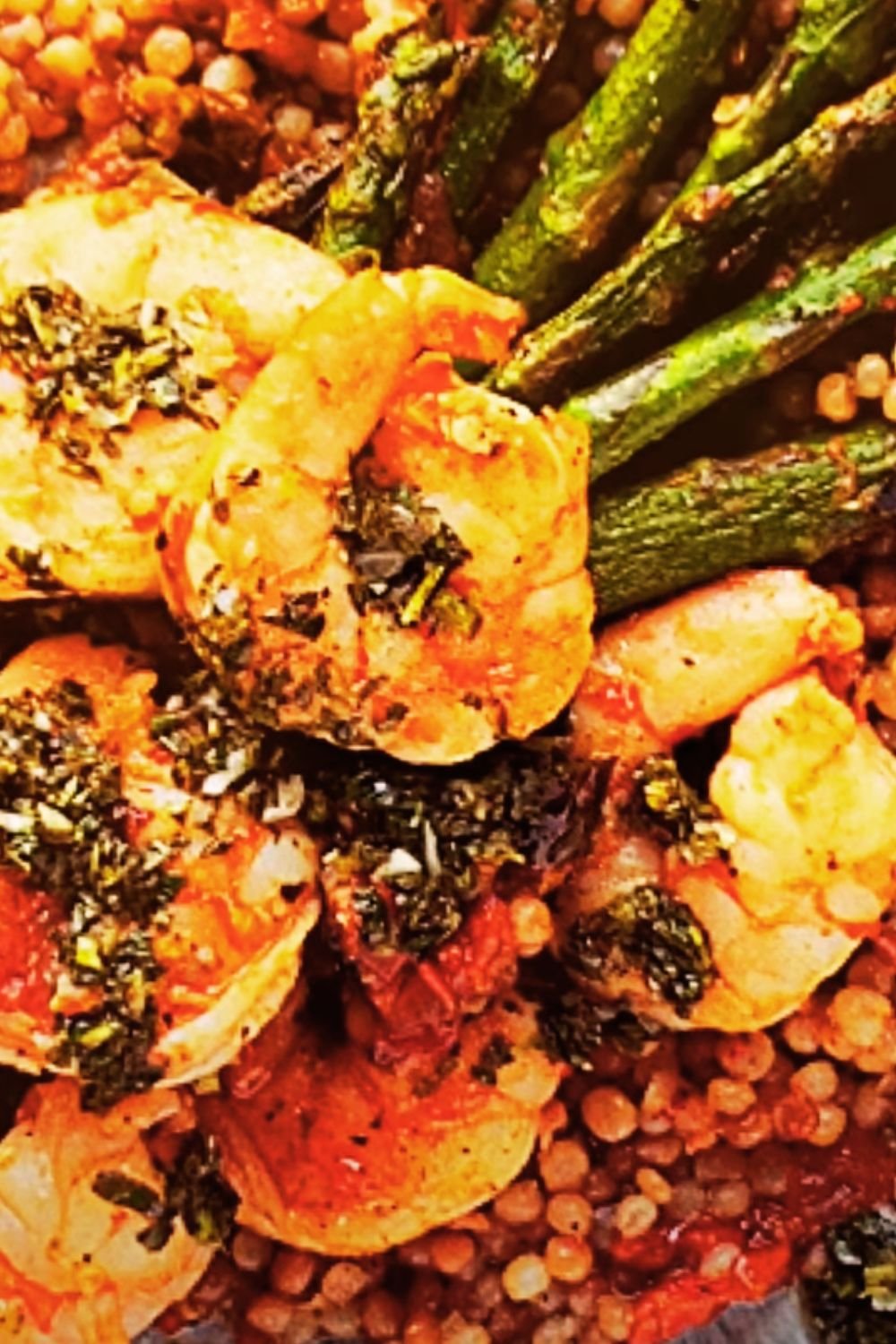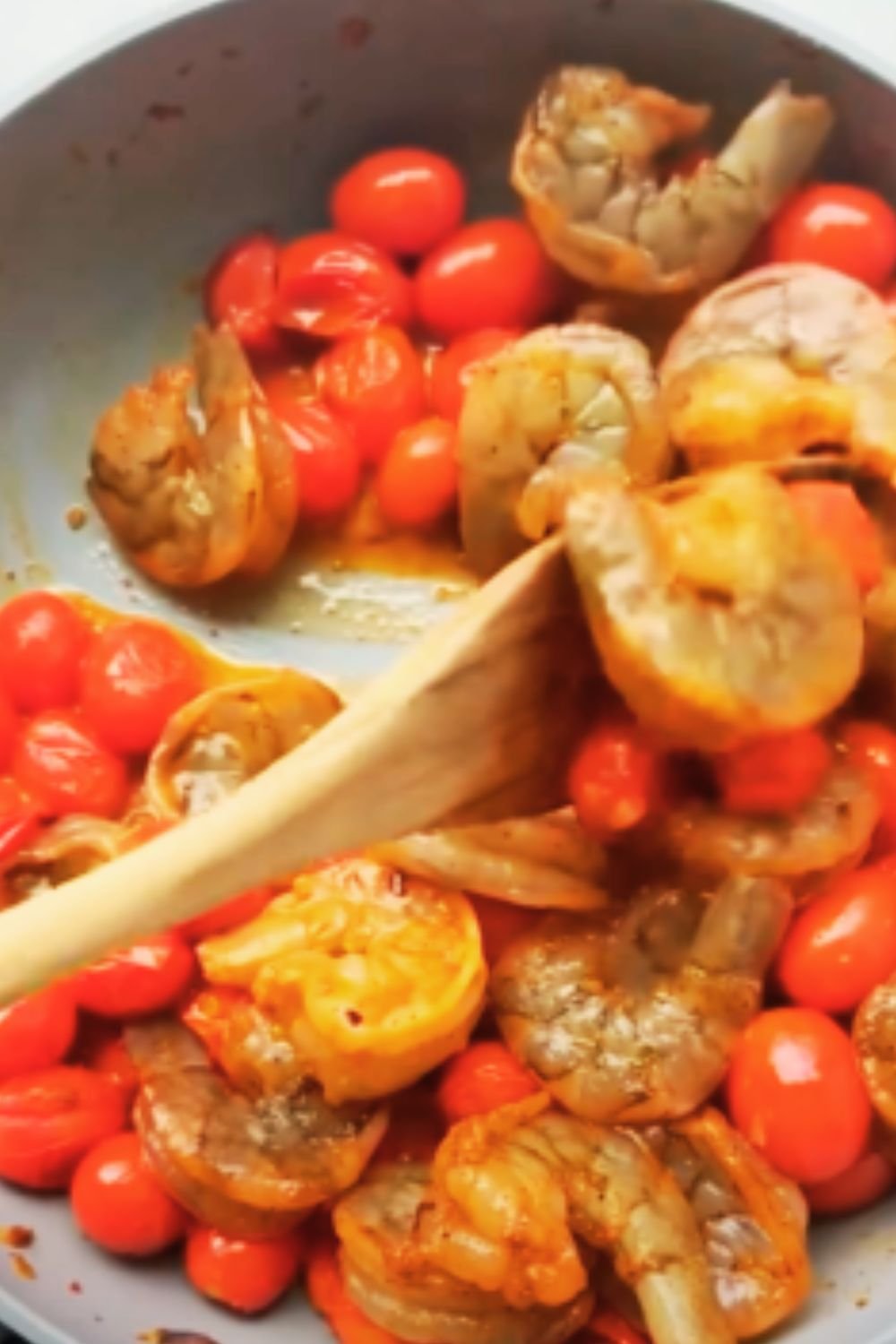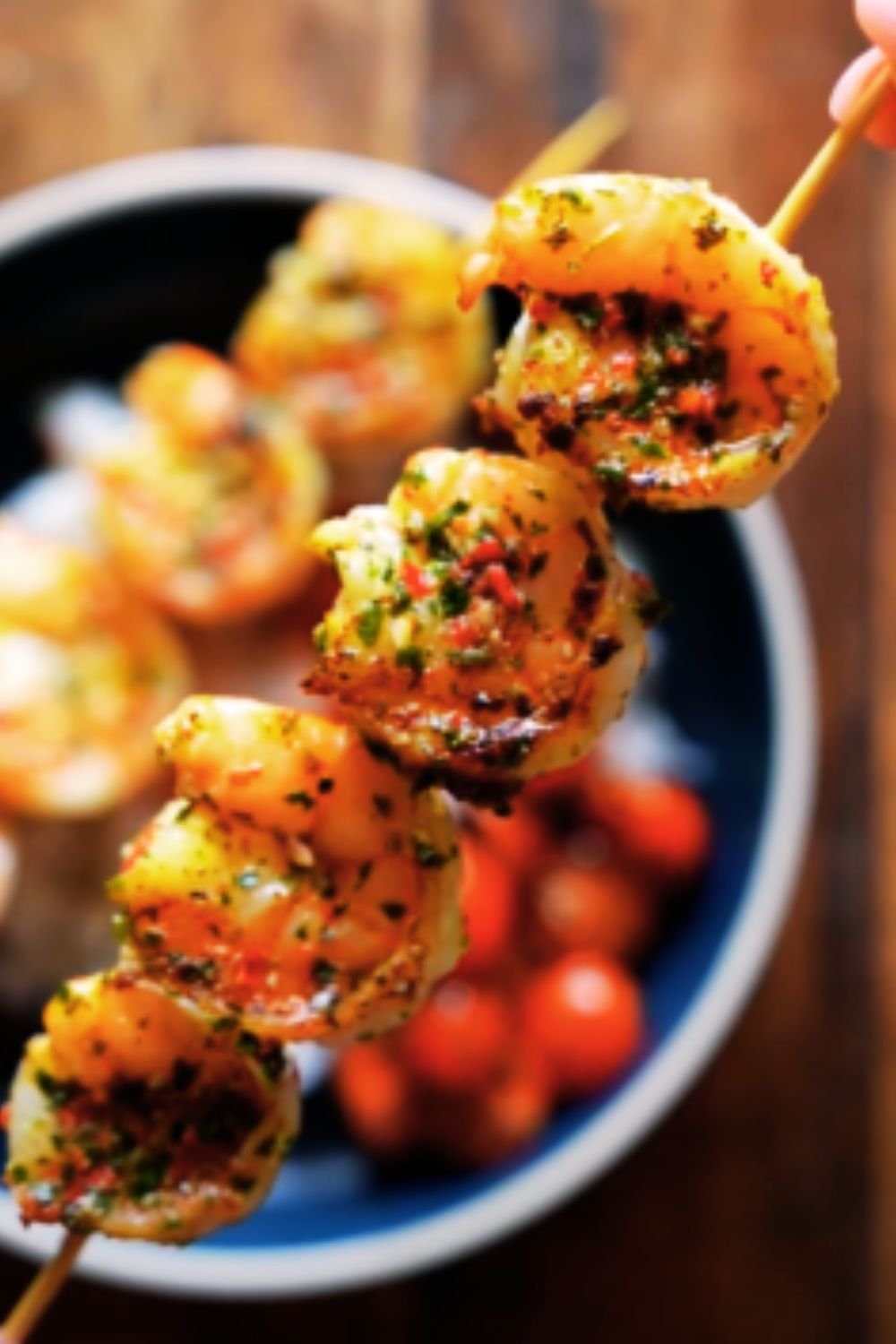Have you ever tasted a dish so vibrant and flavorful that it instantly transports you to another part of the world? That’s exactly what happens when I make my Chimichurri Shrimp. As someone who loves experimenting with global flavors in my kitchen, I’ve found that this South American-inspired dish never fails to impress both my family and dinner guests.
The beauty of Chimichurri Shrimp lies in its perfect balance of bright, herbaceous sauce against succulent shrimp. The zingy, garlicky herb sauce originating from Argentina and Uruguay creates a mouthwatering contrast when paired with tender seafood. I’m excited to share my perfected recipe with you, along with plenty of tips and variations I’ve discovered through years of making this dish.
What is Chimichurri?
Before diving into the recipe, let’s talk about the star of the show: chimichurri sauce. This uncooked sauce is a cornerstone of Argentine and Uruguayan cuisine, traditionally served with grilled meats. However, I’ve found it pairs magnificently with seafood, especially shrimp.
Traditional chimichurri consists of:
- Fresh parsley
- Garlic
- Olive oil
- Red wine vinegar
- Red pepper flakes
- Oregano
- Salt and pepper
What I love about chimichurri is that while it has a traditional base, there’s plenty of room for personal touches. Some variations include cilantro, lemon juice, or even fresh mint. The sauce is incredibly versatile and brings a punch of flavor to virtually anything it touches.
Why Shrimp Works Perfectly with Chimichurri
In my culinary adventures, I’ve discovered that shrimp is the perfect canvas for chimichurri for several reasons:
- Shrimp cooks quickly, making this an ideal weeknight dinner
- The mild, sweet flavor of shrimp doesn’t compete with the bold chimichurri
- The firm texture of properly cooked shrimp stands up well to the chunky sauce
- Shrimp absorbs flavors beautifully, especially when marinated briefly in the sauce
When the herbal, garlicky notes of chimichurri meet the subtle sweetness of shrimp, magic happens on your plate. It’s a combination that feels sophisticated yet is surprisingly simple to prepare.
The Perfect Chimichurri Shrimp Recipe
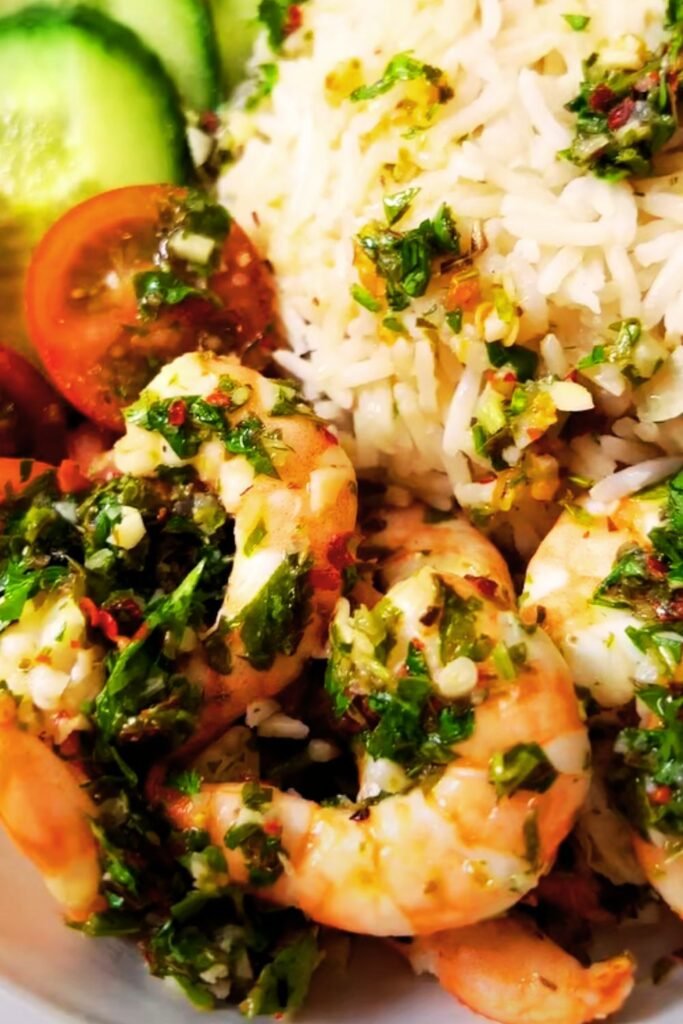
Ingredients
For the Chimichurri Sauce:
- 1 cup fresh parsley, tightly packed and stems removed
- 4 cloves garlic, peeled
- 2 tablespoons fresh oregano leaves (or 2 teaspoons dried oregano)
- 1/2 cup extra virgin olive oil
- 3 tablespoons red wine vinegar
- 1 tablespoon fresh lemon juice
- 1/2 teaspoon red pepper flakes (adjust to taste)
- 3/4 teaspoon sea salt
- 1/4 teaspoon freshly ground black pepper
- Optional: 1/4 cup fresh cilantro
For the Shrimp:
- 2 pounds large shrimp (16-20 count), peeled and deveined, tails on
- 2 tablespoons olive oil
- 1/2 teaspoon salt
- 1/4 teaspoon freshly ground black pepper
- 2 cloves garlic, minced
- 1 tablespoon butter
- Lemon wedges for serving
Equipment Needed:
- Food processor or blender
- Large skillet or grill pan
- Cutting board and knife
- Mixing bowls
- Measuring cups and spoons
Instructions
For the Chimichurri Sauce:
- Add parsley, garlic, oregano, and cilantro (if using) to a food processor. Pulse until finely chopped but not pureed – we want some texture.
- Transfer the herb mixture to a bowl and add olive oil, red wine vinegar, lemon juice, red pepper flakes, salt, and pepper.
- Stir to combine and let sit for at least 10 minutes for the flavors to meld together. The longer it sits, the more flavorful it becomes.
For the Shrimp:
- Pat the shrimp dry with paper towels. This ensures they’ll sear rather than steam.
- In a large bowl, toss the shrimp with olive oil, salt, and pepper.
- Heat a large skillet over medium-high heat. Once hot, add the shrimp in a single layer (work in batches if necessary to avoid overcrowding).
- Cook for about 2 minutes on each side until they turn pink and opaque.
- In the last 30 seconds of cooking, add the minced garlic and butter to the pan and toss to coat the shrimp.
- Remove from heat immediately when shrimp are just cooked through. Overcooked shrimp become rubbery, so timing is crucial.
To Serve:
- Transfer the hot shrimp to a serving platter.
- Spoon generous amounts of chimichurri sauce over the shrimp.
- Serve with lemon wedges and additional chimichurri sauce on the side.
The entire cooking process takes less than 30 minutes, making this an excellent option for both weeknight dinners and special occasions.
Nutritional Information
Here’s a detailed breakdown of what you’re getting in each serving of Chimichurri Shrimp (assuming 4 servings):
| Nutrient | Amount per Serving |
|---|---|
| Calories | 385 |
| Protein | 34g |
| Total Fat | 26g |
| Saturated Fat | 5g |
| Cholesterol | 285mg |
| Carbohydrates | 4g |
| Fiber | 1g |
| Sugars | 0g |
| Sodium | 920mg |
| Vitamin A | 25% DV |
| Vitamin C | 35% DV |
| Calcium | 15% DV |
| Iron | 20% DV |
| Omega-3 Fatty Acids | 0.4g |
This dish delivers an impressive protein punch while keeping carbohydrates minimal, making it suitable for various dietary needs. The healthy fats come primarily from olive oil, which is rich in heart-healthy monounsaturated fats.
Variations and Adaptations
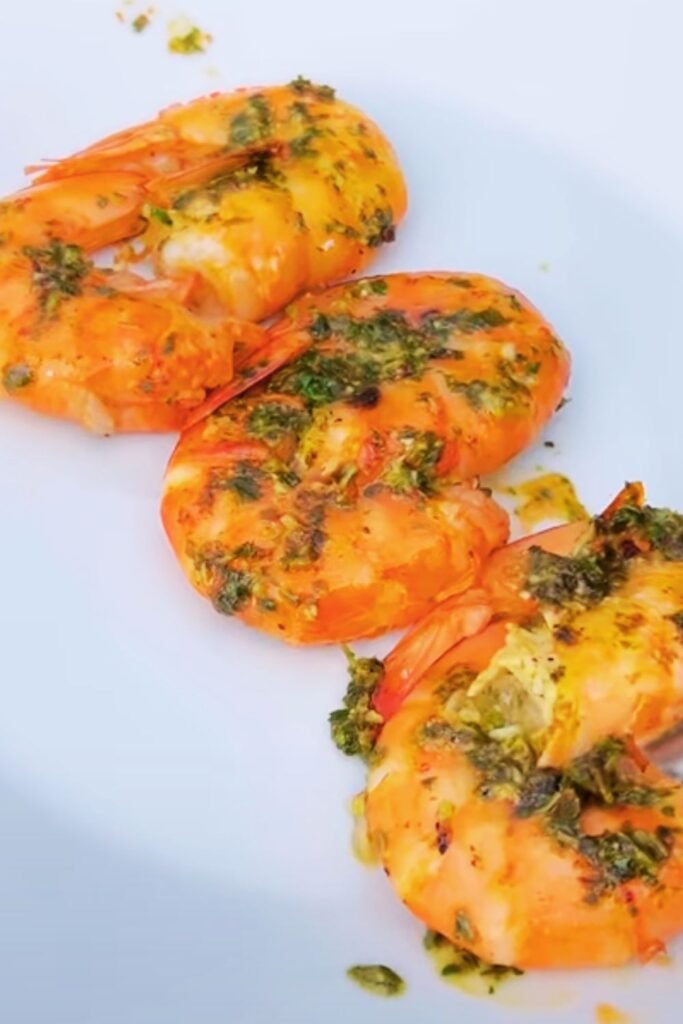
Over years of making this dish, I’ve experimented with numerous variations. Here are some of my favorites:
Cooking Methods
While the recipe above uses a stovetop method, you can also:
Grill the Shrimp:
- Thread shrimp onto skewers after marinating
- Grill over medium-high heat for 2-3 minutes per side
- Brush with additional chimichurri while grilling
Bake in the Oven:
- Arrange seasoned shrimp on a baking sheet
- Bake at 400°F (200°C) for 8-10 minutes
- Toss with chimichurri immediately after removing from oven
Sous Vide Method:
- Set sous vide to 135°F (57°C)
- Season shrimp and seal in a vacuum bag with a tablespoon of chimichurri
- Cook for 15-30 minutes
- Quickly sear in a hot pan for color if desired
- Serve with additional fresh chimichurri
Flavor Variations
Spicy Chimichurri Shrimp:
- Double the red pepper flakes
- Add 1 minced jalapeño to the chimichurri
- Include a pinch of cayenne pepper
Tropical Chimichurri:
- Add 1/4 cup diced ripe mango to the sauce
- Include 2 tablespoons of chopped mint
- Substitute lime juice for lemon juice
Mediterranean Twist:
- Add 2 tablespoons of capers to the chimichurri
- Include 1/4 cup pitted and chopped Kalamata olives
- Stir in 1 tablespoon of anchovy paste for umami depth
Tips for Perfect Chimichurri Shrimp Every Time
After making this dish countless times, I’ve gathered some insights that make a big difference:
Shrimp Selection and Preparation
- Size Matters: I prefer large or jumbo shrimp (16-20 per pound) for this recipe. They’re substantial enough to stand up to the bold chimichurri flavor and less likely to overcook.
- Fresh vs. Frozen: While fresh is wonderful if you live near the coast, high-quality frozen shrimp is often a better option inland. Most “fresh” shrimp at supermarkets was previously frozen anyway.
- Devein Properly: That dark line along the back of the shrimp is the digestive tract. Remove it for better presentation and texture.
- Shell On or Off?: I prefer peeling the shrimp but leaving the tails on for presentation. However, cooking with shells on can add flavor—just remove before tossing with chimichurri.
- Don’t Skip Drying: Pat the shrimp dry before cooking. Excess moisture prevents proper searing and dilutes flavors.
Chimichurri Sauce Mastery
- Hand-Chopping Option: While a food processor is convenient, hand-chopping the herbs gives a more rustic texture that some prefer.
- Oil Quality Matters: Use the best extra virgin olive oil you can afford—it’s a major flavor component.
- Make Ahead: Chimichurri actually improves if made a few hours ahead or even the day before. The flavors have time to meld and develop.
- Temperature Matters: Room temperature chimichurri has the most vibrant flavor. If refrigerated, allow it to come to room temperature before serving.
- Storage: Chimichurri keeps in the refrigerator for up to a week. The olive oil may solidify when cold—this is normal and will liquify at room temperature.
Serving Suggestions

Chimichurri Shrimp pairs beautifully with a variety of sides. My favorites include:
Starchy Sides:
- Crusty artisan bread for sopping up extra sauce
- Cilantro lime rice
- Roasted garlic mashed potatoes
- Polenta cakes
- Quinoa pilaf
Vegetable Pairings:
- Grilled vegetable medley (zucchini, bell peppers, onions)
- Simple green salad with lemon vinaigrette
- Roasted asparagus
- Tomato and avocado salad
- Charred corn off the cob
Complete Meal Ideas:
- Weeknight Dinner: Chimichurri Shrimp with quinoa and roasted broccoli
- Dinner Party Menu: Chimichurri Shrimp appetizer, followed by grilled steak, roasted potatoes, and a green salad
- Summer Feast: Chimichurri Shrimp with grilled corn, watermelon feta salad, and crusty bread
- Light Lunch: Chimichurri Shrimp atop mixed greens with sliced avocado and cherry tomatoes
Beverage Pairings:
- Sparkling water with lime
- Citrus iced tea
- Tropical fruit punch
- Lemonade with fresh mint
Making Ahead and Storage
One aspect I love about this recipe is its flexibility for meal prep and entertaining:
Make-Ahead Components:
- Chimichurri Sauce: Can be made up to 3 days ahead and stored in an airtight container in the refrigerator. The flavors actually improve with time.
- Shrimp Preparation: You can peel and devein shrimp up to 24 hours ahead, storing them covered in the refrigerator. Just be sure to pat them dry before cooking.
Storage and Leftovers:
- Leftover Cooked Shrimp: Store in an airtight container in the refrigerator for up to 2 days.
- Reheating: Gently warm leftover shrimp in a skillet over low heat just until warmed through. Alternatively, enjoy them cold in a salad—sometimes I prefer them this way!
- Freezing: I don’t recommend freezing the finished dish, as the texture of both the shrimp and the sauce will deteriorate. However, extra chimichurri sauce can be frozen in ice cube trays for up to 3 months.
Adaptations for Dietary Needs
This recipe is naturally gluten-free and dairy-free (if you omit the butter when cooking the shrimp), making it adaptable for many dietary requirements. Here are some specific modifications:
Keto/Low-Carb:
The recipe is already low in carbohydrates and perfect for keto diets.
Paleo:
Simply use ghee instead of butter when cooking the shrimp.
Whole30:
Use clarified butter (ghee) and ensure your red wine vinegar has no added sulfites.
Dairy-Free:
Substitute the butter with additional olive oil or use a plant-based butter alternative.
Chimichurri Beyond Shrimp
Once you’ve mastered chimichurri sauce, you’ll find yourself wanting to use it on everything! Here are some of my favorite applications beyond shrimp:
- Grilled steak (especially skirt or flank steak)
- Roasted chicken
- Grilled vegetables
- Baked potatoes
- Scrambled eggs
- Avocado toast
- Mixed into mayonnaise for a flavorful sandwich spread
- Tossed with pasta and cherry tomatoes for a quick dinner
Common Questions About Chimichurri Shrimp
Q: Can I make chimichurri without a food processor? Absolutely! You can finely chop all the herbs and garlic by hand and mix with the remaining ingredients. Some people actually prefer the texture of hand-chopped chimichurri.
Q: My chimichurri turned brown after a day in the refrigerator. Is it still good? Yes, this is normal oxidation of the fresh herbs. The sauce is still perfectly fine to eat, though it may have lost some of its vibrant color. To minimize browning, make sure your chimichurri is in an airtight container with a thin layer of olive oil on top.
Q: Is chimichurri sauce spicy? Traditional chimichurri has a mild to moderate heat from red pepper flakes. You can easily adjust the spice level by increasing or decreasing the amount of pepper flakes to suit your preference.
Q: What’s the best way to tell when shrimp are perfectly cooked? Perfectly cooked shrimp turn from translucent gray to opaque pink and form a “C” shape. If they curl into a tight “O” shape, they’re overcooked. Remember that shrimp continue cooking briefly after being removed from heat.
Q: Can I use pre-cooked shrimp for this recipe? While fresh shrimp are ideal, you can use pre-cooked shrimp in a pinch. Skip the cooking process and instead quickly warm the shrimp in a pan with a bit of olive oil before tossing with the chimichurri sauce.
Q: Can I make this recipe with frozen herbs if fresh aren’t available? Fresh herbs are strongly preferred for chimichurri, but in a pinch, you can use frozen herbs (not dried) for the parsley and cilantro. The flavor won’t be quite as vibrant, but it will still be delicious.
Q: How can I make this dish more economical? Consider using smaller shrimp (they’re usually less expensive) or even substituting another protein like chicken. You can also stretch the dish by serving it over rice or with plenty of crusty bread.
Final Thoughts
Chimichurri Shrimp has become one of my signature dishes for good reason. It’s the perfect balance of simplicity and sophistication—easy enough for weeknight cooking but impressive enough for entertaining.
What I love most about this dish is its versatility. Whether you’re serving it as a main course with rice and vegetables, presenting it as an appetizer on small plates, or adding it to pasta for a quick dinner, Chimichurri Shrimp never disappoints.
The vibrant, herbaceous sauce against the tender, succulent shrimp creates a flavor combination that feels both exciting and comforting. It’s the kind of dish that makes everyday meals feel special without requiring hours in the kitchen.
I hope you’ll give this recipe a try and make it your own. Once you master the basic chimichurri sauce, you’ll find yourself reaching for this flavor profile again and again. It just might become your new go-to dish for both busy weeknights and special occasions.

